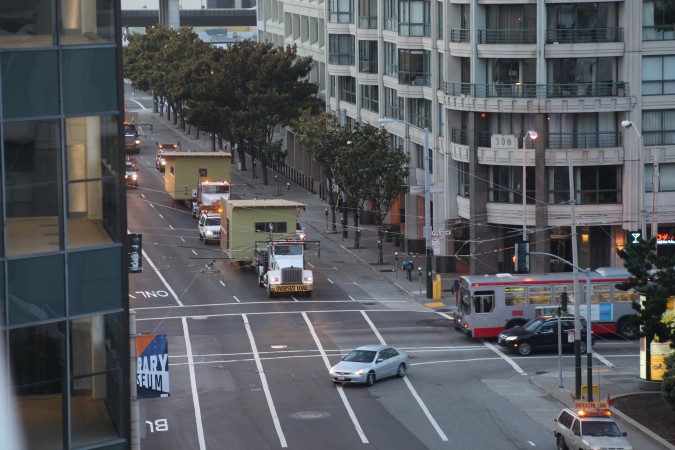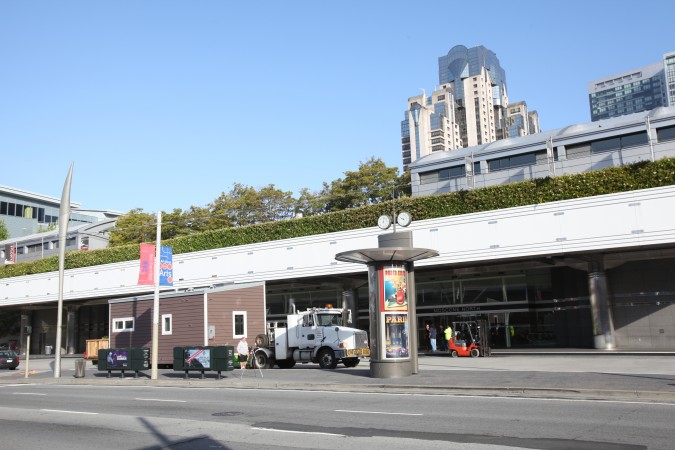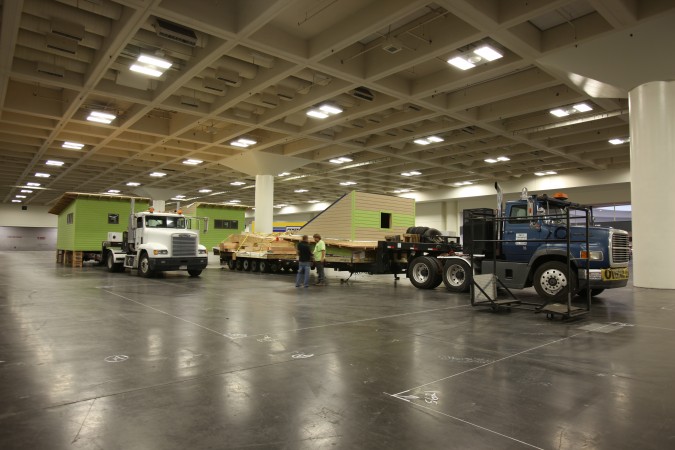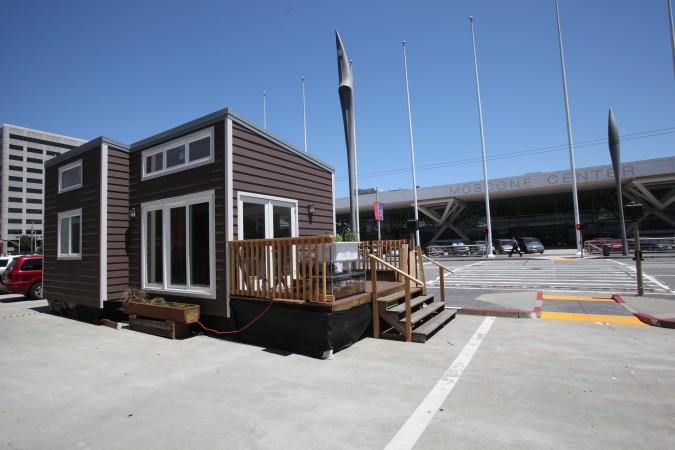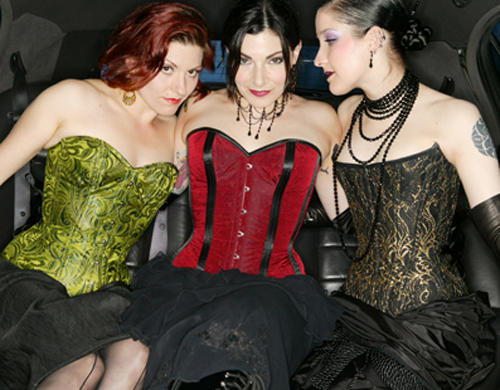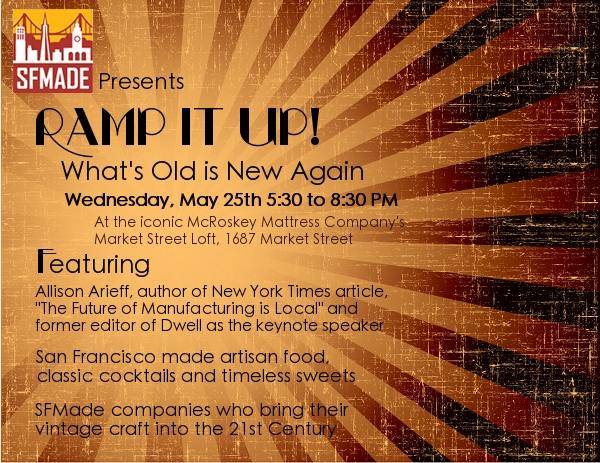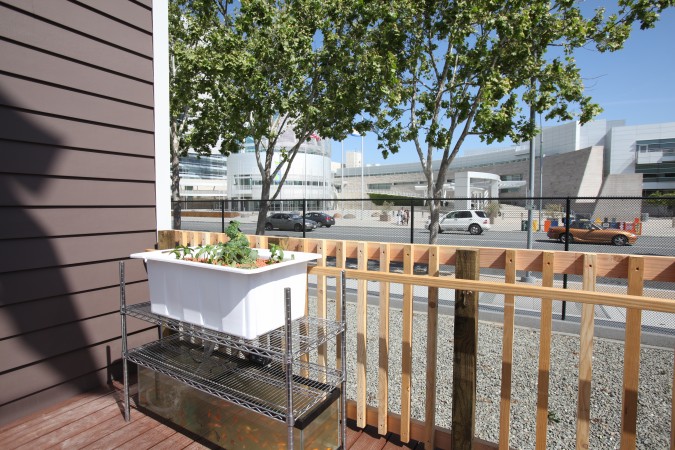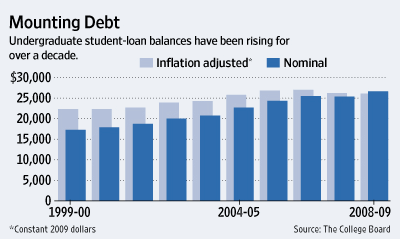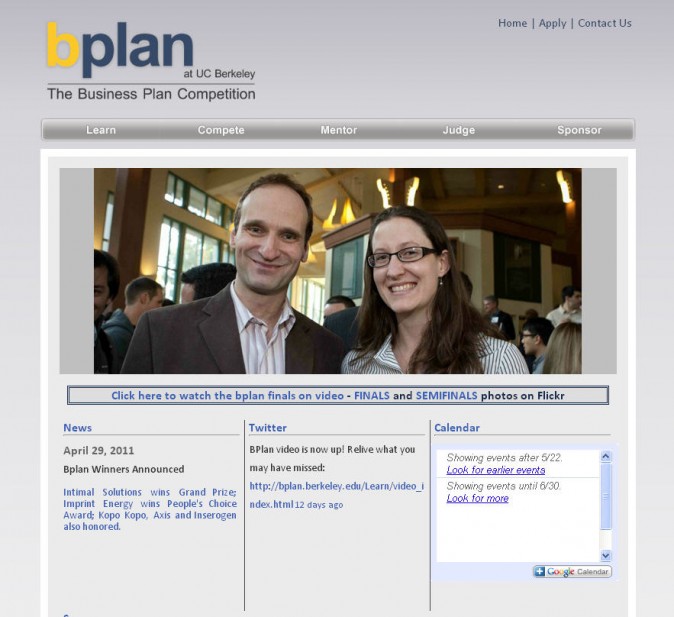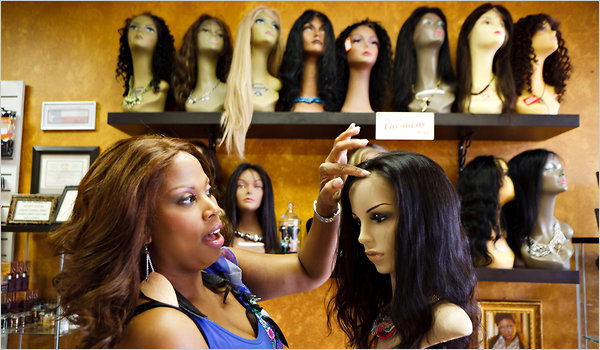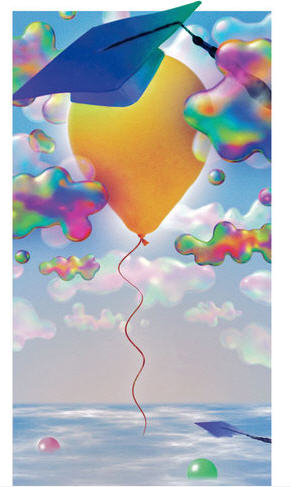Archive for 2011
New Avenue brings two of its homes to Moscone Center for the Pacific Coast Builders Conference June 22-24, 2011
My friend Kevin Casey is on a roll with his New Avenue, Inc. startup.
Today he was literally on a roll, or, rather, two of his company’s products were rolling up Route 101 from San Jose, California to San Francisco, California, about 50 miles.
New Avenue designs, finances, builds and installs quality ADUs, which stands for Accessory Dwelling Units. ADUs are commonly known in the US as inlaw units or granny units. An ADU is a smaller house destined to be a second home on a single family residential lot. It’s public policy and official law in California that cities allow ADUs.
The two New Avenue products rolling up 101 are houses ready for decades of full time living. These are not cheap mobile homes destined for the scrap heap in 15 or 20 years. These are quality homes built with high quality materials and appliances. New Avenue homes are luxurious enough that they make sense in even the backyards of wealthy Californians.
I’ve a big fan of what Casey is doing, and I’ve written here about New Avenue four times before. I have even toyed with the idea of ‘competing’ with Casey by making ADUs from recycled ocean shipping containers. I’ve shelved those plans to focus my efforts on gOffice and its companion blog. But the concept of living in a smartly designed smaller home that consumes fewer resources is profoundly appealing to me, which is why I follow Casey’s progress with such fascination.
As I wrote about here last month, Kevin Casey invited me to build an aquaponics system for one of his homes. That home has been on public display in front of the new City Hall in San Jose, CA for the last six weeks or so. San Jose was gracious enough to allow Casey to reposition the house for a week so it could be shown publically at the Pacific Coast Builders Conference (PCBC), happening at the Moscone [Convention] Center in San Francisco June 22-24, 2011, next week.
San Jose paid Casey to build the house as part of a green technology exhibit called the San Jose Green Vision Clean Energy Showcase funded by the United States Department of Energy with Recovery Act money. It was via the San Jose exhbit that New Avenue came to the attention of the PCBC conference, which paid Casey to design and build the larger ~750 square foot house you see disassembled on the three semi trucks in the picture at the top of this article. This green home which is also green in color, will be a centerpiece of the PCBC convention, and it is literally in the center of Moscone North. The houses were delivered at 5:50 this morning, just as the sun was rising, so that’s why the picture is dark… note the reflection of the headlights on the pavement. I was extremely lucky that the Moscone parking garage opened 15 minutes early at 5:45am. If it hadn’t, I wouldn’t have been six stories up with a windowless view of 3rd street to take the picture above. Thank you to the garage staff!
The San Jose exhibit house, painted brown, is now in the driveway in front of Moscone North, at street level. This means thousands of cars will pass this house for the next week or so, and thousands of people will walk past it. As far as I know, no admission will be charged for members of the public to tour this house, so you don’t need to be a paid attendee of the PCBC conference to pay a visit.
The aquaponics system I built for Casey is on the front deck, just as it is when the house in in San Jose. The plants in the grow bed survived the windy truck ride North without cover, to my amazement. I didn’t want to risk the fish splashing out of the aquarium onto the roadway, so I removed them yesterday and brought them home with me in my car. I cleaned up the tank, filled it with declorinated fresh water and reintroduced the fish to their home this afternoon, once the New Avenue house was safely parked in San Francisco.
I will be on hand during the PCBC conference to explain aquaponics to visitors. I already told a dozen people about aquaponics today — mostly Moscone Center staff, including Lorenzo, a journeyman painter who engaged me in 20 minutes of conversation about small home living and gardening. He was extremely enthusiastic about aquaponics and the New Avenue house… he really wanted the house for his vacation property where he goes hunting and fishing.
I shot video of the house moves, and it’s being encoded for upload as I write this post. I will add a companion post tomorrow to show that video. These houses are so large they needed multiple escort vehicles to get to San Francisco safely. It was quite a spectacle watching the 750 square foot home be delivered by three trucks into the convention center. Be sure to have a look at that video on June 18, 2011.
My company website now has a blog at http://blog.goffice.com
Today I start blogging in two places:
Why it took me more than 8 years after I started gOffice to start blogging on that site I don’t know.
Totally crazy…
Introducing FaceSeat to remotely attend weddings and funerals
Since Apple iPad tablet computers have forward and rear facing video cameras, and are set up for slick and easy video conferencing, I have a proposal:
Make iPads available for check out in hospitals and nursing homes, so that patients can receive ‘hospital visits’ from their friends and family more frequently.
I bet that if a scientific study were conducted that patients would get well sooner and be happier if they could video chat with their friends and family for free, even if they didn’t own or know how to operated a computer. I suspect the video chatting on the iPad is so easy to use that nurses and doctors could be trained to be trainers in mere minutes.
I suspect there are already robust WiFi networks in care facilities, so the networking is already in place.
While we’re at it, install permanent video cameras at all funeral homes so people can attend even if too far away to travel.
For that matter, install video cameras at churches and other places where weddings take place, so more people can attend weddings.
For an extra dose of ‘being there’ somebody could create a holder for an iPad that would look sort of like a person from the sholders up. Where the face would be, place the iPad. This iPad holder could be clipped to the back of a chair or bench.
This way a church, wedding venue or funeral home might have 10 ‘remote seats’ available, where one iPad equals one seat. When someone is occupying a seat at home, their face is shown full screen on the remote iPad. In this way, the physically present attendees can see the faces of the remote guests, and the relatives will be comforted that more friends and family could attend.
Since all these iPads cost money, I suppose it would be OK for wedding and funeral venues to charge extra for these virtual seats. But I would say just give them away at first, to get people hooked on the concept. It’s such a far out idea I am doubtful people would pay until they had seen it done at another event.
I read once that when the grocery shopping cart was invented and placed in stores that nobody touched them. The proprietor had to hire pretend shoppers to push them around as if they were really shopping. That educated actual shoppers, who began to use the carts themselves for real. I think something similar might be required to get this idea off the ground. It might even be necessary to hire fake guests who do not know the wedding party or the deceased, to virtually attend the wedding or funeral, cry and be present.
I’ve read that in Japan there are businesses that rent actors to attend weddings in person to give the impression the bride and groom have more friends than they really do. So there is a precedent for fakery like this.
I think the idea of virtually attending important life events is a good one. Especially going forward with jet fuel being so expensive and security standards getting stricter. It just isn’t a great idea to fly all over the planet for all these events, and such travel I predict will one day become politically incorrect.
There are so many ways to make my idea more like being there. The iPads could be mounted on motorized tripod mounts the remote user could adjust, so people could look to their sides and say hello to real people. The iPad has a camera on the back already, so people could see who was sitting behind them. Maybe two iPads could be mounted back to back so that people sitting in the back could see who was sitting up front in the virtual seats.
Lots of people miss lots of important events. My idea is much more social than simply installing some anonymous cameras that might be security cameras as far as the attendees are aware. With my idea, people present physically can interact with people present virtually.
I dub my idea FaceSeat.
Of course, this concept is applicable to zillions of events beyond weddings and funerals, but at first I would focus on these big markets — a lot of people marry and die in the world.
With the provocative name FaceSeat I could get sued by Apple and FaceBook at once. Think of the stunning PR that would result – instant mind share. If Oprah [Winfrey] still had a popular daytime television show, I’d be on it within days of the lawsuits being filed.
PS — This is just a wacky idea I’m writing on my blog! I am not jumping into to the videoconferencing industry. If someone has already thought of and published my idea, I’d like to know about it so I can update this post.
I met the founder of Dark Garden at SFMade’s Ramp It Up event
I met Autumn Adamme this evening at Ramp It Up, a fundraiser by SFMade.
I first wrote about SFMade in February, 2011.
Adamme is the founder of Dark Garden, a San Francisco manufacturer of fine women’s corsets. Adamme operates a retail store at 321 Linden Street, and I believe all her products are made at the store.
I found Adamme to be inspiring. She moved away from home at age 16 and started Dark Garden in her garage when she was only 18 years old, in 1989. She has operated this business continuously her entire adult life. I can’t think of any other entrepreneur that started so young and stayed with their original venture for as long. Adamme looks to be about 30 years old, so she hasn’t let the daily grind of running a successful business beat her down.
Dark Garden is a lovely store. I was there a couple of times helping a woman select and buy a corset. The staff is very pleasant and passionate about what they’re doing. The location is down a small street, and the decor is funky, warm and sexy – I found it a perfect environment for what they sell. I’ve been to many high end lingerie stores, and while Dark Garden isn’t selling lingerie, I found the vibe at the Dark Garden store the most appealing, personal and real of all.
I’m writing abut Dark Garden because I am considering leaving the Internet entrepreneurship world and getting into manufacturing. This is a big and somewhat scary move for me. I love hearing stories like those Adamme shared with me this evening, and I wanted to let her know that she made an impression on my thinking.
I’m attending Ramp It Up, a fundraiser by SFMade.org
I’m considering manufacturing self contained green homes in San Francisco, California. I don’t know much about the manufacturing business, and I have few contacts in the industry. To help fix that, I’m going to the first SFMade annual fund raiser tonight.
SFMade is a new trade organization that formed to promote the interests of companies that manufacture physical goods in San Francisco.
I first wrote about SFMade on Feburary 28, 2011.
Here’s the link to the event page for this SFMade event, titled Ramp It Up.
The ticket price is USD $45.00, of which USD $25.00 is tax deductible under US tax laws.
I built my first aquaponics system – you’ll never guess where it is
I’ve written about my friend Kevin Casey a few times before (January 7, 2011, January 9, 2011 and January 11, 2011). I met him in 2007 when he was one of the student organizers for the University of California Berkeley Business Plan Competition. I was a judge and financial sponsor for that competition, so we had plenty of opportunities to talk. We became friends on Facebook, and when he started posting status updates about his startup New Avenue, Inc., I got back in touch with him.
Kevin staged the ribbon cutting for his first house on January 8th, 2011. Soon after, the city of San Jose, California contacted Kevin and asked that he construct a custom house for a 9 month exhibit of green technologies called the San Jose Green Vision Clean Energy Showcase. This exhibit opened this month, in May, 2011. The location is directly across the street from the sparkling City Hall of San Jose.
Here’s the PDF brochure that San Jose is distributing about its Clean Energy Showcase.
Ever since I contacted Kevin in late 2010, I have been talking his ear off about my ideas for shipping container based green housing. One of the parts to my grand plans is to make it practical for residents to grow food at home. The most exciting and productive way to grow food in limited space with limited water is to raise fish and vegetables in symbiotic harmony. This technique is widely known by the word ‘aquaponics.’
Kevin approached me and asked if I’d like to set up a small demonstration aquaponics system on the front porch of his New Avenue demo green home. I jumped at the chance, as this gives me a great excuse to learn more about this and help a friend at the same time. Aquaponics is really popular in Australia, which is in the midst of an 11 year draught. Aquaponics systems use 1/10th the water required to grow vegetables in dirt. Since the world is ‘running out’ of fresh water, it makes sense to learn more about a system that makes such efficient use of water.
I put together a system with off the shelf parts I selected and modified personally. The result doesn’t look bad, but doesn’t look like a commercial polished product either. I am happy with the result for my first system. I used a wire shelf rack from Costco as the frame. I was concerned that infants could drown in a system that didn’t fully cover the water tank, so by setting the height of the first shelf to just over the height of the water tank, I eliminated that risk. You can see this safety feature in the picture above.
The water aerator and the timer are located in an exterior grade water resistant steel junction box fastened to the rear shelf. From there, the system is connected to a GFCI outdoor outlet on the rear of the house. While you can’t see it in the picture because I hadn’t installed it yet, the fish are fed automatically each day via a timed automatic fish feeder.
The vegetable bed is flooded with a foot of water from the fish tank 24 times a day. The flood/drain cycle takes about 18 minutes, and starts on the top of each hour. The pump consumes just 18 watts during a 15 minute per hour fill cycle. The extra 3 minutes is the time it takes for the growing bed to drain back into the fish tank.
The vegetable roots cleanse the water. Since the vegetables get all the water they can absorb, they grow faster than in dirt, up to 600% faster. The fish also grow faster than normal because they get so much clean and well aerated water. It’s a true win/win scenario. The main inputs are fish food and water to replace what is lost to transpiration and evaporation. On occasion, there are tiny inputs of a teaspoon or so of fluid to adjust the pH to keep everything happy. I understand that this is needed primarily during the first 6 weeks of operation, before the healthy bacteria have established themselves in the clay beads that the plants grow in.
I am no expert, but I’m learning a lot, and I appreciate the opportunity to learn on such a public stage. I’ve already met two people that have seen my system and want one of their own!
To learn more, read Backyard Aquaponics Magazine.
Special thanks to Sylvia Berstein, Founder and CEO of The Aquaponic Source, who helped me set up my first system and sold me some of the key parts. Her store is located in Boulder, Colorado, USA.
Money lessons for everyone
I read Money Lessons for Every High-School Graduate by Zac Bissonnette in today’s Wall Street Journal newspaper. Bissonnette’s piece is one of the most direct and sensible articles about money I’ve yet read.
While the lessons of this article are aimed at recent high school graduates, I think the lessons have yet to be learned by many people.
Lesson number four particularly resonates with me:
“Materialism is misery: Lives of thrift and conscientiousness lead to less stress, greater enjoyment of the things we do have and a lighter carbon footprint. But most of our societal associations with wealth are deeply connected with materialism: luxury goods, power and status.
“The more materialistic values are at the center of our lives, the more our quality of life is diminished,” says Knox College psychologist Tim Kasser, author of “The High Price of Materialism.”
Recognize the real benefits of wealth — freedom and flexibility — and don’t let the pursuit of its illusory trappings interfere with your ability to reap those rewards.”
Thanks to my generous relatives, rental and investment income, I have the freedom and flexibility the passage refers to.
That makes me richer than almost everyone I know, in my mind.
Even better, I am happy. I like my house, car and possessions, and I rarely dream of upgrading them.
Might I appreciate a gilded existence? Perhaps, but perhaps not, because with material riches come pressures that I have seen make many people unhappy.
I’ll take my happy, freedom filled middle class life over an unhappy, constrained upper class life… with joy.
I am confident I’ll make a lot more money, but happiness is more important than money.
4. Materialism is misery: Lives of thrift and conscientiousness lead to less stress, greater enjoyment of the things we do have and a lighter carbon footprint. But most of our societal associations with wealth are deeply connected with materialism: luxury goods, power and status.
“The more materialistic values are at the center of our lives, the more our quality of life is diminished,” says Knox College psychologist Tim Kasser, author of “The High Price of Materialism.”
Recognize the real benefits of wealth — freedom and flexibility — and don’t let the pursuit of its illusory trappings interfere with your ability to reap those rewards.
I’m on the front page of the Berkeley Business Plan Competition website
Here’s something I never expected:
My picture is on the front page of the Berkeley Business Plan Competition website.
I’m pictured with AutoTB Co-Founder and CEO Kelly Karns. AutoTB won the competition in 2009. This picture was taken by long time Berkeley event photographer Bruce Cook at the public finals awards ceremony on April 28, 2011.
I’m a judge and sponsor for the Berkeley Business Plan Competition, and I was a contestant in 1999.
Stealing hair for money
Here’s an article entitled ‘Costly Hairstyle Is a Beauty Trend That Draws Thieves’ Notice’ about the crime of stealing human hair. I had no idea thieves stole hair on an epic scale until I read this article. The salon owner pictured below had $150,000 worth of hair stolen from her business during one such theft. Thankfully, the thieves are not taking the hair directly from its source.
Is college is too easy?
The opinion piece published May 14, 2011 in The New York Times newspaper entitled Your So-Called Education makes a good case that university and college students are being cheated by their schools.
I have several friends that graduate this month from University of California, Berkeley. I hope they see this blog post and can comment publicly or privately whether they agree with the authors.
I certainly feel that the classes at University of California at Los Angeles, where I went, were too easy. The only classes I recall that really challenged me were Astrophysics and Computer Programming. The Astrophysics class was an AP level course, and I really had to work hard. But I remember a lot from that class today. The Computer Programming class was not an AP level class, but it was also really hard work. That class was the single most important class of my life, as it laid the groundwork for me to become a programmer.
All the other classes were forgettable and not challenging.
I’m nearly certain I learned to write in high school, not at university. The classes at Laboratory School, where I went to high school in Chicago, were harder than most of the classes I took at UCLA.
When I was at Brooks Institute, after UCLA, the classes were a joke. I could and usually did pass them with only one day a week of work. I regret I didn’t instead attend Art Center, in Passadena, CA, which reportedly required that an assignment be turned in 5 days a week. This would have been painful at the time, but beneficial to me in the long run.
If you are thinking about enrolling at Brooks, save your money. It was a full fledged economic scam. Yes, I learned to take pretty good pictures, but that was because of my talent for it that I developed after graduation. They could have compressed their ‘4 year program’ into six months of actual hard work and saved my parents a fortune. A Brooks Institute degree used to cost about what a Stanford University degree used to cost. I should have gone to Stanford. I’m certain I could have kept up with and done the work, given what I know of my Stanford graduate friends. In fact, I have a strong and powerful suspicion that even most of the classes at Stanford aren’t particularly challenging.
Comments?
